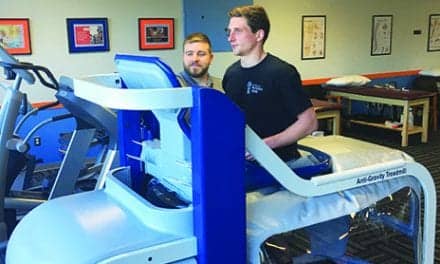Severe stroke victims and other acutely ill rehabilitation patients are learning to correct their unsteady and unsafe gait sooner and without the fear of falling by using a new therapeutic device that allows them more freedom of motion to walk again, says the inventor.
"The device, called Navigaitor, helps patients who are unstable or too weak to walk without fear of falls and injury and without depending on several physical therapists for support," said inventor Avital Fast, MD, chairman of rehabilitation medicine at Montefiore Medical Center and Albert Einstein College of Medicine, New York.
The computer-driven device holds patients up with a standard harness attached via a cable to a sensor on a sturdy, overhead frame made of steel beams, he said, via a statement released by Montefiore. The device physically supports, responds to, and follows the patient as he/she walks safely in all directions—forward, backward, sideways and up and down inclines, Fast says.
The Navigaitor has helped a severe stroke patient with no strength in her left arm and leg to walk up an incline in five sessions, versus weeks, and it has helped an elderly man with advanced idiopathic myositis, a musculature disease, to lift his legs in just a few sessions, Fast says. It is also being used to help patients with Parkinson’s disease and Guillain-Barre syndrome, and can adapt to patients’ needs and function under full weight-bearing and partial weight-bearing conditions, he says.
"Giving patients freedom of motion to walk safely suspended on the harness and to change direction at will, as in a real life, rather than have their movements restricted to a treadmill or track, is important in speeding the recovery process," Fast said in the statement. "We now know that the brain is plastic and that repetitive movements play a role in helping the brain develop nerve ending junctions that bypass the areas of the brain damaged by a stroke. The sooner we begin training the muscles and the brain to interact in real-life situations, the sooner the brain’s circuitry rearranges and the healing process can begin."
A 200-square-foot frame of steel beams defines the boundaries of the therapeutic space. The frame’s dimensions can be tailored to different room sizes in hospitals, nursing homes, and free-standing rehabilitation centers. The harness hangs from a mobile ceiling beam that crosses the width of the therapeutic space. As the patient moves, the harness cable pushes against a tilt mechanism that feeds information to a computer. The computer directs the mobile beam and harness to move with the patient inside the therapeutic space.
The inspiration for the Navigaitor came 7 years ago when, as a consultant, Fast saw two patients who had fallen and injured themselves severely during therapy sessions at other hospitals. It has been successfully used by a dozen patients in the past few weeks and is evolving daily, he says. Along with the engineers from the University of Hartford who helped build the device, Fast is customizing it for Parkinson’s disease patients who cannot initiate their stride, he says. The system will be programmed to give them a slight boost to start walking.
There are also plans underway to teach patients how to walk over ice and on sand and to practice therapeutic walking in a real life environment, such as a living room with couches and a TV, he says.
In the months ahead, Fast plans to collect clinical data and submit the results for publication. He shares a patent on the device with Montefiore, University of Hartford, and Devdas Shetty, PhD, of University of Hartford.
[Source: Montefiore Medical Cente]




